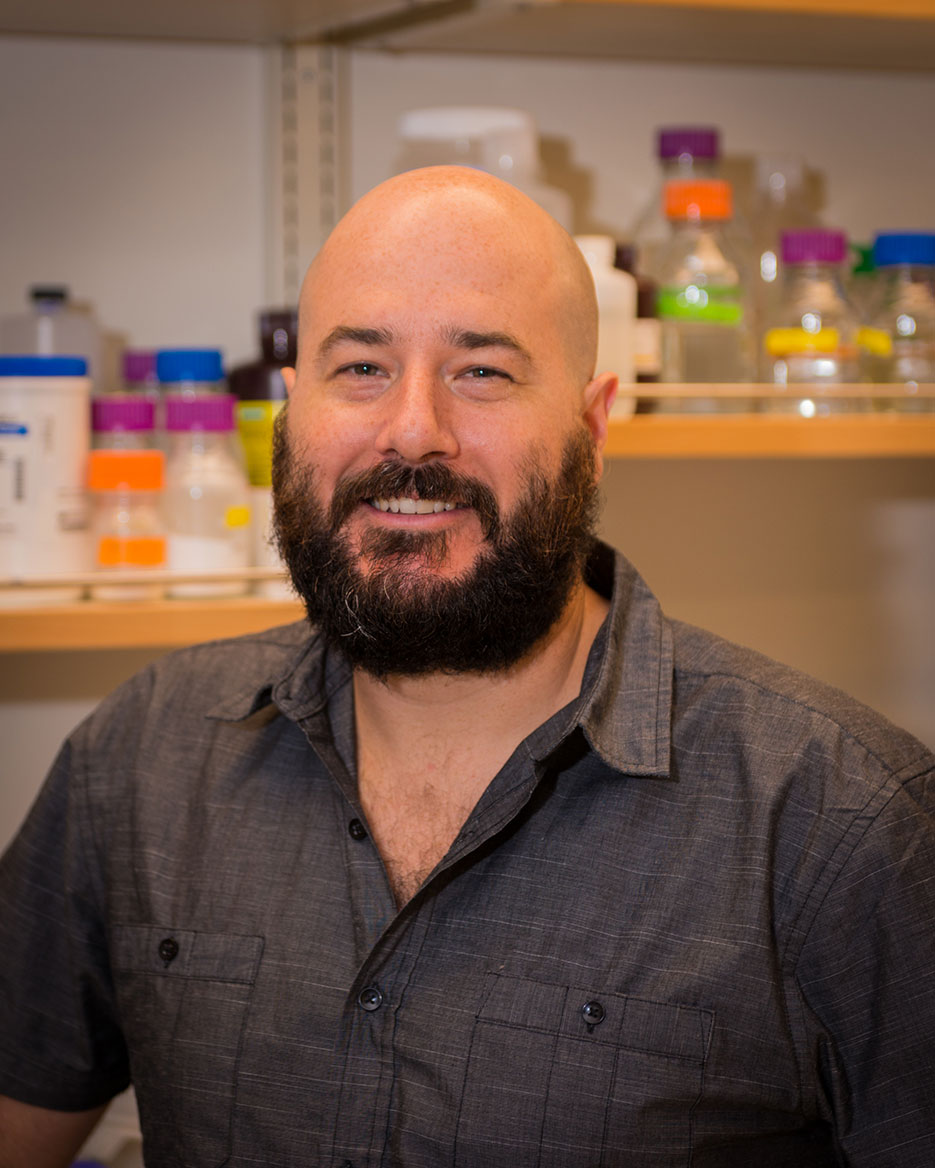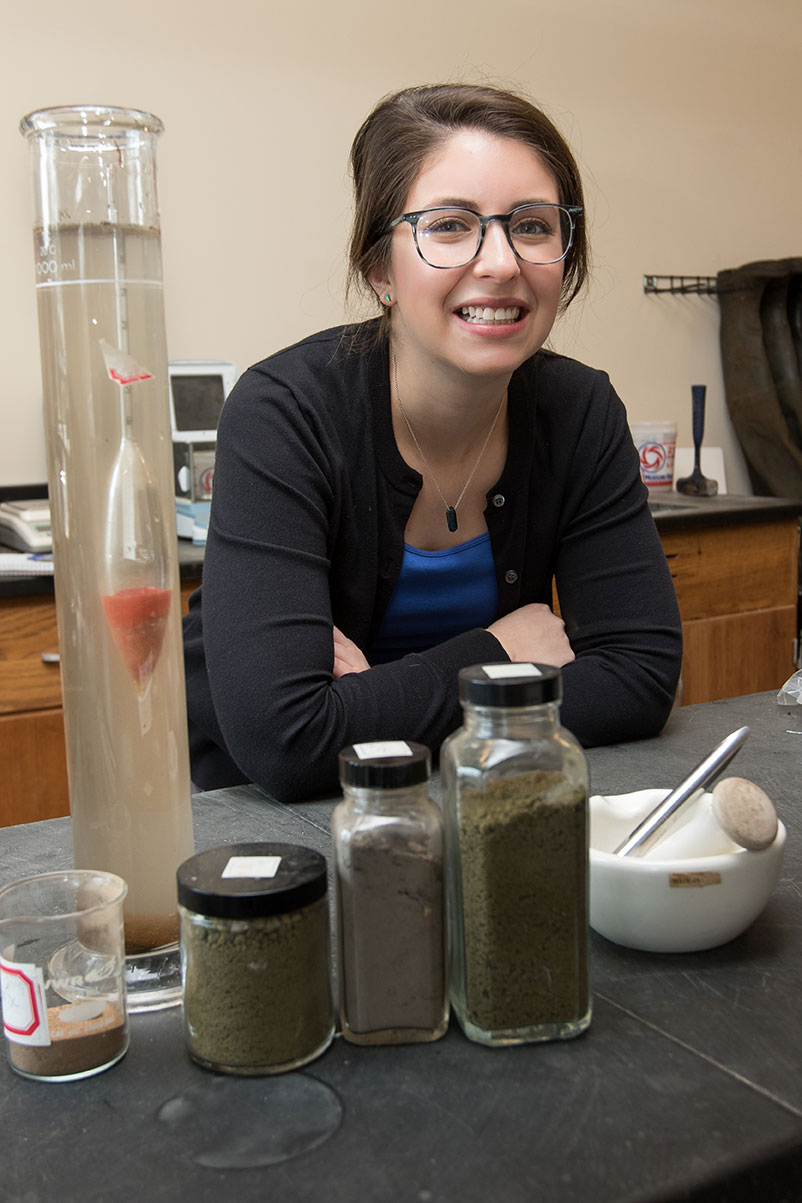Meet Our New Faculty
Summer 2018 Issue
Meet Our New Faculty
This past fall, The School of Natural Sciences & Mathematics welcomed several new
faculty members. Meet two of our new full-time tenure-track faculty.
Dr. Michael Law '00
Assistant Professor of Biology

Dr. Micahel Law (Photo credit: Adam Redding)
I am a first-year Assistant Professor of Biology and am also a Stockton University alumnus. I have many fond memories of my time as a student at Stockton. I knew that I was interested in studying science but was uncertain about what career path I should follow. After considering medical school and ecology, I had an opportunity to work in Dr. Peter Straub’s laboratory performing independent research. While working with Dr. Straub, I was able to cultivate my inquisitive nature and really capture the true essence of scientific discovery. Perhaps the most interesting thing about my research project was that it was a miserable failure. Nothing worked, yet I was captivated. This convinced me that I belonged in the lab and I set my sights on earning my Ph.D. for a career as an academic scientist.
After completing my undergraduate degree, I decided to postpone my graduate education and travel around the world. I fell in love with traveling as an undergraduate as I had the opportunity to visit many foreign countries. I pursued this passion during a year-long trip that took me to South America, Asia, and Eastern Europe. This trip was centered around learning about cultural diversity, world history and experiencing nature through hiking and surfing. It was a once in a lifetime opportunity that taught me things that cannot be learned in a classroom or laboratory.
"My dissertation project was focused on understanding the biophysical properties that mediate interactions between proteins and RNA."
When I returned from my trip, I began teaching middle school science while submitting applications for graduate school. I was accepted by the University of Southern California and earned my Ph.D. in Biochemistry and Molecular Biology in four years. I worked with one of the greatest mentors, Dr. Ite Laird-Offringa, who taught me many important things about how to be a great scientist and how to lead a life of balance. My dissertation project was focused on understanding the biophysical properties that mediate interactions between proteins and RNA. This project has very little to do with what I work on now, but it was an excellent starting point that taught me about quantitative and analytical approaches in science.
After completing my Ph.D., I applied for a postdoctoral research position at the University of Medicine and Dentistry of New Jersey. There I worked in the laboratory of Dr. Randy Strich, who was interested in understanding transcriptional controls during yeast meiosis. This research allowed me to develop a new set of skills using a classical experimental model. I was awarded a highly prestigious Ruth L. Kirschstein National Research Service Award which funded my project for three years.
After my postdoctoral position was finished, I was promoted twice; first to a junior faculty position, then to a tenure-track assistant professor. At that point, I started my own research laboratory focused on cell fate decisions. While performing my own research was rewarding, I still desired to go back to the place where it all started; Stockton University. Through my diverse experiences I had learned that Stockton is a special place that allows faculty members to cultivate inquisitive minds. I also knew that the University was growing with new construction projects in Galloway and other locations. This growth, coupled with the positive culture here at Stockton, was very attractive to me. I am thrilled to now be a member of the Stockton faculty and am looking forward to enjoying many productive years and contributing to the positive learning environment.
Dr. Jessica Favorito '12
Assistant Professor of Environmental Science
I graduated with a B.S. in Chemistry with a concentration in Environmental Chemistry from Stockton University. My experiences at Stockton were what inspired me to pursue a career focusing on the environment and soil science. It also helped that Stockton is tucked away in the beautiful, serene Pine Barrens. I have such fond memories of sitting out by Lake Fred, running through the trails around campus, and spending labs out in the soil pits.
After graduating from Stockton, I moved on to pursue a doctoral degree at Virginia Tech studying soil chemistry. I learned along the way that soils are both beautiful and intricate, which are two words I do not believe most people associate with them. Having said this, what interests me are the aspects of soils and complexities that we cannot see.
"What interests me are the aspects of soils and complexities that we cannot see."

Dr. Jessica Favorito (Photo credit: Susan Allen)
For the past five years, my research focused on trace inorganic soil contaminants, their behavior in soil, soil-plant relationships, and mechanisms of uptake by plants. I explored phosphate mine soils from Idaho and the contaminant, selenium. The problem with selenium is that it is found in very high levels in soils following phosphate mining reclamation in the west. It is sourced from the Middle Waste Shale member of the Phosphoria formation. Some of the soils that I examined contained over 400 ppm selenium, while background levels of unaffected soils fall within a range of 0.2 ppm. This is compounded by its availability to plants due to conditions that favor this in the dry western U.S. climate. Particular native plant species found throughout this region are known as selenium hyperaccumulators, meaning that they can absorb very high quantities of selenium. Previous works have indicated that certain species, particularly the western mountain aster, can accumulate levels of up to 13,000 ppm selenium. Ungulates happen to graze on these selenium-rich plants, typically resulting in fatalities shortly thereafter. For reference, less than one cup of aster containing the aforementioned levels is lethal to grazing livestock and will likely kill them in a 24 to 48 hour period. Identifying reasons for this increased bioavailability and methods of mitigation was like putting a puzzle together. One outcome of this work was that I was able to develop a quick method for site assessment using simple soil water extracts to identify bioavailable selenium hotspots. I also identified particular organic acids produced by plant roots that could increase selenium bioavailability to plants throughout the region. This was interesting because I was finding low levels of the most plant available form of selenium present, selenate. It is thought that perhaps organic acids were competing with forms of selenium that are typically bound to soil particles, like selenite. This truly is interesting, thought-provoking research but also very important. There are toxic substances throughout the many spheres of our environment that are dangerous and oftentimes, anthropogenic. It should be more important to us to fix the problems we create.
At Stockton, I am in the beginning stages of research involving another soil contaminant, copper, related to fungicide application of grapevines at the Stockton campus farm. While grapevines inherently require fungicide use due to aggressive fungal pathogens that destroy grapes, my undergraduate students and I are identifying its distribution in sandy Pine Barrens soils, its uptake by grapevines, how much is transferred to wine products, and methods of copper sequestration in soil. Ultimately, I would like to expand this research to vineyards across Southern New Jersey. This is a very exciting time for me, and I am incredibly grateful to be back at Stockton.



